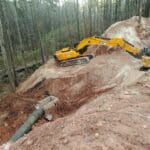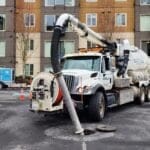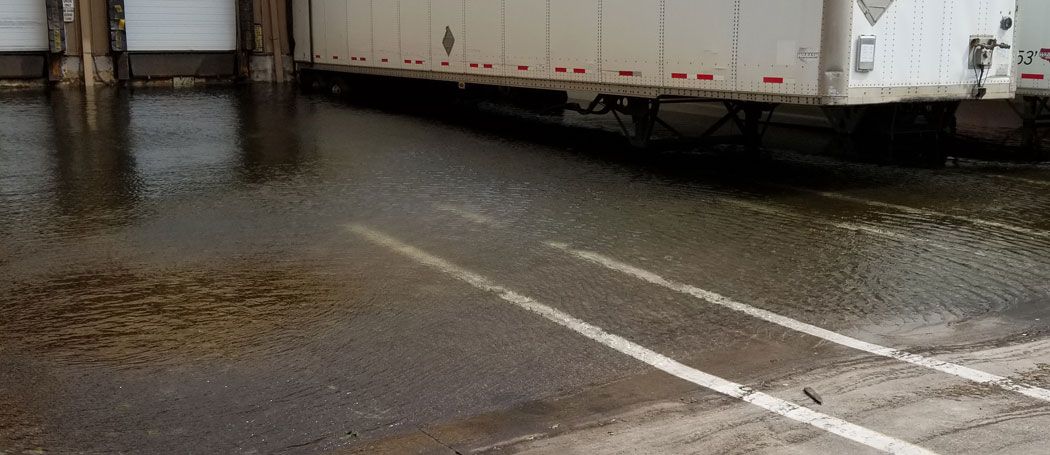Extreme Rain Events: Lessons on Hurricane Runoff Learned from Florence
It’s been a busy couple of weeks in the AQUALIS office. Hurricane Florence brought on high wind speeds, torrential rainfall, and hurricane runoff that caused flooding in many parts of the Carolinas. This environmental disaster has left much of the coastline still reeling, with citizens displaced and their properties’ fate still up in the air. Although it is important to respond to the needs of those still displaced, it’s also important to think about how effective the stormwater facilities we have in place to minimize damage even during extreme rain events were. In the aftermath of Hurricane Florence, it’s important to not only take stock in how we prepared and acted, but to also look forward towards the next extreme rain event.
When we walked into work last week, our entire team was concerned with getting prepared to help clients within the possible scope of Florence in any way they could, before and after the hurricane occurred. All possible maintenance crews were mobilized to the areas that needed maintenance preparation, a vital component to ensuring stormwater assets are ready for the damage a hurricane causes. In order to get every property ready, maintenance crews needed to remove organic debris that could potentially cause blockage, release turn valves to provide extra stormwater storage and flood control, and set up trash pumps for dewatering ponds for stormwater assets that don’t have turn valve capability. Our team also dispatched all possible equipment that would normally be needed in extreme rain events to areas that would require it most, including pumps, shop vacs, generators, and chainsaws, to revert any damage the hurricane would cause as quickly as possible. Even after mobilizing maintenance crews and equipment, our people were constantly monitoring weather updates and models in order to stay on top of what areas would be affected in the event we needed to move crews around. Our main focus was on preparing all sites by ensuring all Stormwater Control Measures assets (SCMs) were working impeccably and being available for any client who needed us. Although damage is inevitable in a hurricane, being proactive can drastically minimize that damage.
Extreme rain events like Hurricane Florence can wreak all kinds of havoc on properties and their stormwater infrastructure. Heavy flowing hurricane runoff can alter the property’s landscape, causing erosion to occur along basin walls and at inflow points. Heavy rains and high wind speeds also often cause tree and land damage that creates an abundance of loose plant debris and an excess of sediment that can easily clog stormwater pipes. This can in turn block low-flows, causing backup and overflow of stormwater in the property’s SCMs. Because hurricanes expel so much rainwater as it moves along its path, there are times when the heavy flow of hurricane runoff can overtax stormwater assets that aren’t regularly checked for wear and tear and create structural problems, especially with SCMs that are not regularly inspected. This can manifest in a variety of ways, including pipes being out of alignment due to a leak or burst in the material, causing misdirected water to pool in unexpected and undesirable places and expand on any existing damage. The heavy flow that can overtax unmaintained systems can also overflow and increase the likelihood of stormwater overflowing from established SCMs, picking up everything it comes into contact with as it moves towards our waterways, including trash, sediment, bacteria, plant debris, and animal waste. All of these unwelcome additions to the hurricane runoff can create some nasty effects on our wildlife and public health if left unmanaged. With all the destruction that extreme rain events can cause, it’s cost-effective and more sustainable to minimize any unfortunate possibilities by maintaining your stormwater assets.
Even in the aftermath of Florence, lakes and rivers are continuing to fill from the hurricane runoff that is flowing into waterways, which could cause more flooding and damage as waterways overflow. Because of this, our teams are continuing to monitor rainfall and flooding data in order to quickly service any affected client’s damaged properties. Preparations of maintenance crew and equipment placement taken before the storm have made our response to service orders uncomplicated and prompt. Although many properties sustained some type of damage, we are confident in our crews to get them back to normal soon. Well maintained stormwater assets were able to withstand the worst of the storm, as they were designed to do. Our focus now is on recovering all stormwater assets back to their best potential so they are prepared for whatever weather event may happen next.
As we pick up the pieces from Hurricane Florence, life in the Carolinas is going back to business as usual. Although hurricanes can be a huge devastation on our daily lives and our physical environment, the peace of mind in having stormwater management professionals at AQUALIS on hand to protect and recover your facilities can make that devastation more manageable. Contact one of our professionals today to get your stormwater assets prepared for whatever weather event may come your way.
 Kenosha, Wis. Highway KR Regenerative Stormwater ConveyanceThe Root-Pike Watershed Initiative Network Kenosha County, and others worked with AQUALIS to design and implement an innovative solution for stormwater control along Highway KR.
Kenosha, Wis. Highway KR Regenerative Stormwater ConveyanceThe Root-Pike Watershed Initiative Network Kenosha County, and others worked with AQUALIS to design and implement an innovative solution for stormwater control along Highway KR. Durham, N.C. Sinkhole Leads to Stormwater System RehabilitationThe tenant on this property noticed a depression that opened to the ground below and notified the property owners.
Durham, N.C. Sinkhole Leads to Stormwater System RehabilitationThe tenant on this property noticed a depression that opened to the ground below and notified the property owners.

